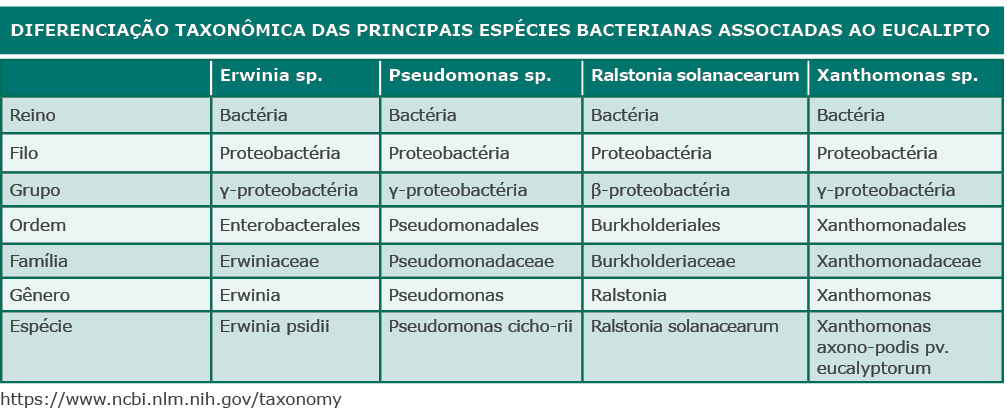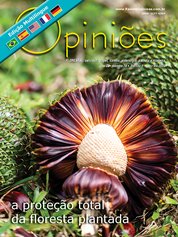Edson Luiz Furtado
Professor of Forest Pathology at Unesp-Botucatu
OpCP70
Management of bacterial diseases in eucalyptus
Co-authorship: Luís Thadeo Poianas Silva, Professor at the Faculty of Agricultural Sciences, Department of Plant Protection at Unesp
Brazil is a world reference in the production of eucalyptus, due to its actions based on sustainability, competitiveness and innovation. One of the most important components in guaranteeing productivity, after resistance, is the integrated management of pests and diseases. Among the diseases, those that attack the root, trunk, vascular system, and foliar system stand out. In this article, we will focus on foliar diseases of bacterial origin, which encompass a group of pathogens with a certain morphological similarity, requiring biochemical and molecular studies for the characterization of these pathogens.
The damage begins in the nursery, where it causes a reduction in the productivity of seedlings and can continue to the definitive planting, where it can cause intense defoliation, drying of branches and tips and plant mortality, depending on the species of pathogen involved.
Eucalyptus and bacterial diseases:
The area with forest crops in Brazil is more than nine million hectares. These plantations are mainly located in the states of Bahia, Mato Grosso do Sul, Minas Gerais and São Paulo. Several species of Eucalyptus are cultivated in the world, and in Brazil, with high productivity, due to genetic improvement and Forest Protection programs, which ensure that the Brazilian forestry sector is one of the most competitive in the world. The forest-based sector represents 1.2% of the National Gross Domestic Product, with total gross revenue of 97.4 billion reais, generating income for 3.75 million Brazilians. However, the planting of eucalyptus in large homogeneous massifs, with few clone species, favors the occurrence of diseases and pests, with economic losses.
The best-known bacterial diseases in eucalyptus are vascular wilts, caused by Ralstonia solanacearum, the leaf spots, with the Xanthomonas species complex and Pseudomonas, leaf spots, the drying of buds in a clonal garden and the drying of branches and buds by Enterobacteriaceae (Highlighted table).

Ralstonia wilt was reported in Brazil, for the first time, in the early 1980s, in the municipality of Prata, Minas Gerais, in Eucalyptus plantations grandis. In 2005, the losses of seedlings and propagules in the cuttings multiplication phase were estimated and it was concluded that the disease resulted in high economic losses in eucalyptus nurseries in the states of Bahia, Espírito Santo, Maranhão, Minas Gerais and Pará, totaling a damage estimated at 50 million reais.
Bacterial spot caused by the Xanthomonas species bacterial complex and Pseudomonas obtained its first records in the mid-1990s on seedlings of the Eucalyptus species, in nurseries in the state of São Paulo. In a survey carried out between 2003 and 2008, in twelve nurseries in the states of Bahia, Goiás, Minas Gerais and Rio Grande do Sul, around 15 million reais were lost, with discards of 11,266,819 seedlings and 553,991 mini- stumps.
Finally, the eucalyptus pointer drought, first caused by Erwinia psidii, originated initially in Uruguay and Argentina and later in Brazil. Between 2010 and 2016, in southern Brazil, around 314 hectares of areas with eucalyptus plantations were affected by the disease, with medium and high severity, reducing growth in height and circumference at breast height. Until, in 2019, they found the genus Pantoea and other enterobacteria, associated with the symptoms.
Therefore, there is a real need for further studies regarding the reported phytobacteria, in order to clarify the interaction between them and the increasing damage to forest plantations, since the control of bacterial diseases in plants is generally difficult, making it practically impossible. after the onset of the epidemic. Management must start in the clonal garden, and measures must be taken, even in the nursery, to prevent these pathogens from reaching the field. The aim of this work is to highlight control measures and management for this important group of phytopathogens.
Management of bacterial diseases:
We have pointed out, in our courses in the company of “Integrated Management of Nursery Diseases”, that asepsis and cleaning measures are essential to move towards “ground zero” of bacterial diseases, combined with an accurate diagnosis method. These enemies of the nursery can enter the installations through the tubes , with dirt that arrives from the field, through the substrate used in the formation of seedlings, through the irrigation water, through the seedlings and clones that form the mini-garden and through the trucks used to transport the inputs.
Within the Integrated Management of Nursery Diseases, preventive measures are advocated, in short: to have an adequate outline, separating the contaminated area (reception of tubes, batter and tube washer) from the clonal garden and staking area. As well as the deposit of inputs must be external to this area. The tractor to enter with tubes and inputs must pass through a pool with chlorine, called foot-de-luvium, removing dirt from the tires. Proceed to treat tubes and trays with heated water (at 85 degrees centigrade for 1 minute). Periodically, carry out the PCR test, with primers specific to the water and substrate, as well as to the dispatched seedlings.
Make periodic visits to all parts of the nursery: clonal garden, greenhouses and growth and expedition area. When locating plants with symptoms, carry out field diagnosis; if in doubt, send material to the Forestry Pathology Laboratory of the Faculty of Agricultural Sciences, for laboratory diagnosis. The eradication of stumps and diseased plants is an adequate measure against enterobacteria and Ralstonia wilt. For leaf spots, mark the stumps and apply an authorized bactericide and/or resistance inducer. In clones very susceptible to enterobacteria and Ralstonia wilt , replace these clones with resistant materials.
Inspection of seedlings to be sent to the field must be carried out by people trained in visual diagnosis; for Xanthomonas stains Pseudomonas, seedlings must be free of spots and have more than 10 pairs of leaves. For enterobacteria and Ralstonia, which are endophytic at this stage, perform the PCR test periodically, with primers specific. In the event that infected seedlings arrive and are planted in the field, the damage and losses can be very high, as there are still no effective control measures for these bacterial diseases.




